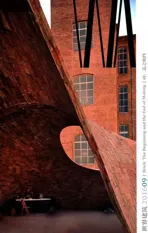妇女发展促进中心,卡永扎,卢旺达
2016-10-19建筑设计莎伦戴维斯设计事务所
建筑设计:莎伦·戴维斯设计事务所
妇女发展促进中心,卡永扎,卢旺达
建筑设计:莎伦·戴维斯设计事务所
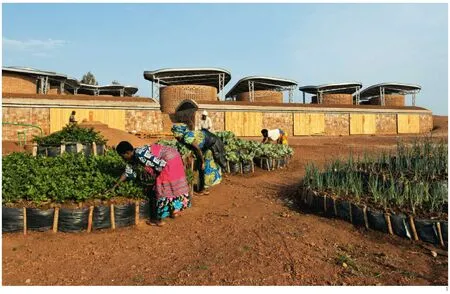
1 外景/Exterior view
妇女发展促进中心是与国际妇女互助组织合作设计的。地段占地10,000m2,距离卢旺达首都大约一小时车程。在设计过程中,我们遵循了以下原则:为社群争取权益、创造经济机会、重建社会基础结构。
我们将一座卢旺达村落作为建筑布局的参考原则,把一簇人体尺度的小房间围合布置,以营造安全感,增强社区凝聚力。建筑中的功能包括教室、客房、一座展示性农场(由绿色屋顶遮阳,并由夯土墙支撑),以及一座市场,妇女可在此售卖她们在现场中制作的商品。
建筑所需的大约500,000块粘土砖都是由当地妇女在此制造的,并且结合了对当地烧砖工艺的部分改进,例如:采用钢模具、较干的粘土配比、燃烧替代材料(非木材)。因此,这些妇女学会了可市场化的、带来收入的技能,如今她们生产的手工砖是该地区质量最高的。
在很多方面,妇女发展促进中心的设计概念来源于砖。项目的主要赞助人向我们提议,应该让社区的女性成员共同制作砖块,并用它来建造属于自己的学校。这个简单的概念逐步发展,对这个设计以及社区产生了深远影响。我们首先调研了当地的制砖工艺。这些砖块的审美及结构质量都欠佳,原因是在制作过程中所使用的一系列落后的技术。在投资一小部分资金用于培训、工具及资源改良后,我们为妇女发展促进中心生产建筑材料而成立的妇女制砖公司很快成为了一家自给自足的制砖企业。
我们从卢旺达传统空间营造技术中吸取的另一灵感,是用相互咬合的圆弧来创造空间,就像在办公及工作室空间的平面中那样。我们将多个弯曲的砖墙组合起来,创造出大小及形状都不同的空间。砖的尺度很小,使我们得以轻松地建造出半径很小的圆弧,从而实现编织空间的概念。
教室所采用的轻盈而开放的螺旋平面也源自卢旺达传统建筑中介于“室内”和“室外”之间的模糊性概念。螺旋线形取消了通常用来展现入口界限的门,让住户能在不打断课堂的情况下悄悄进出,同时墙体旋转开启的形式也让室外空间融入室内。(黄华青 译)
项目信息/Credits and Data
客户/Client: 国际妇女互助组织/Women for Women International
建筑用途/Building's Purpose: 社区中心,教育及公共空间/ Community Center, education & public space
建筑面积/Usable Floor Area: 2200m2
砖材类型/Brick Type:手工砖/Handmade bricks
建造周期/Construction Period : 2011.09 – 2013.07
摄影/Photos: Elizabeth Felicella (fig.1, 3-5, 7), Bruce Engel(fig.8-10)
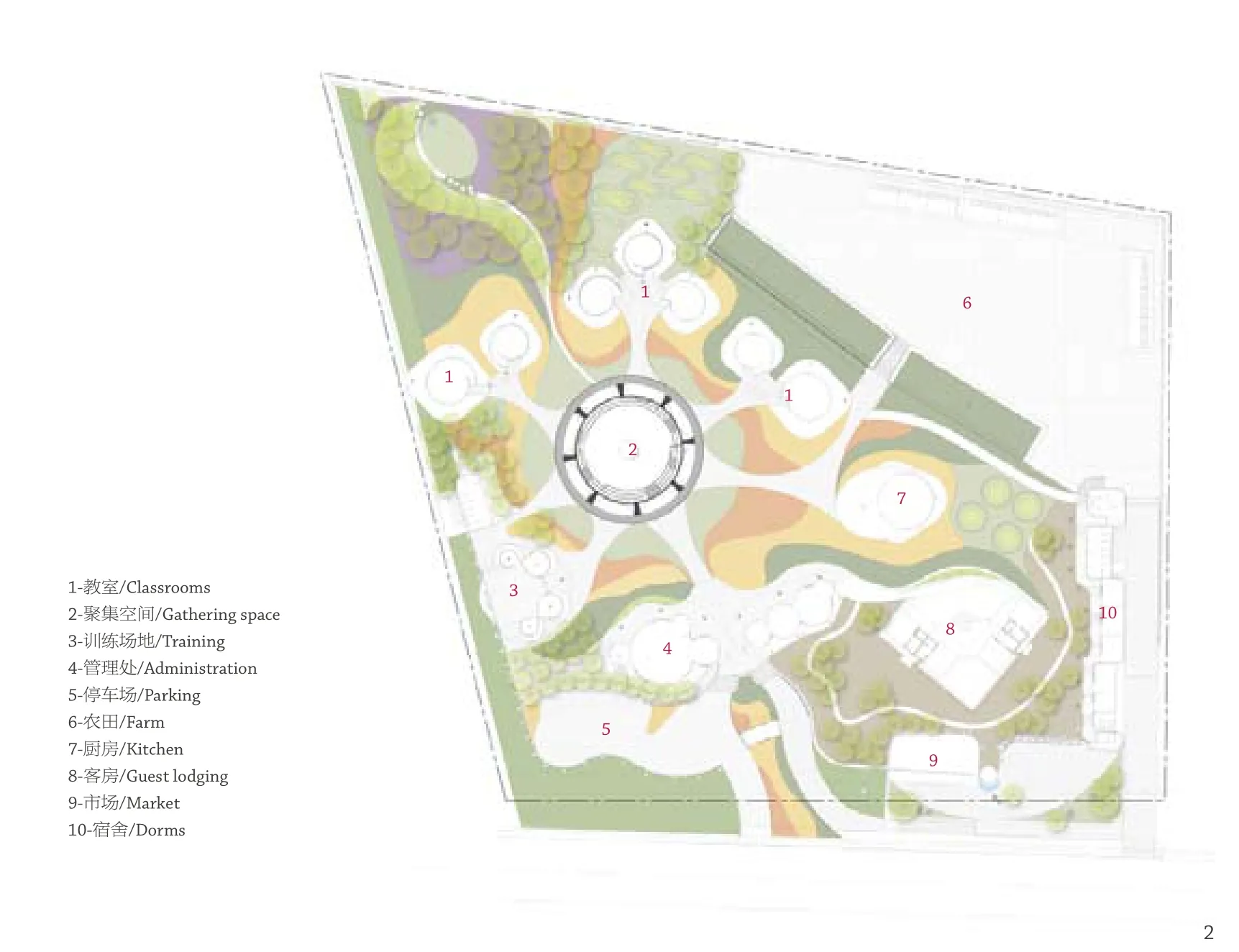
2 总平面/Site plan
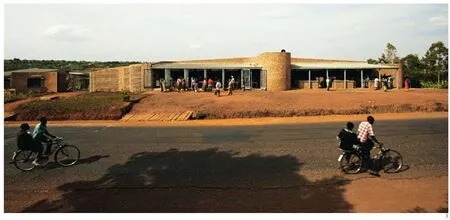
The Women's Opportunity Center (WOC),designed in collaboration with Women for Women International, occupies a one-hectare site one hour from the Rwandan capital and has been developed with the following objectives in mind: to empower its community, create economic opportunity, and rebuild social infrastructure.
Referencing to a Rwandan village as our organizing principle, we clustered human-scaled pavilions to create security and cultivate the sense of community. Facilities include class rooms, guest lodgings, a demonstration farm–cooled by a green roof and retained earth walls–and a marketplace,where women sell products they have made on site.
The approximately 500,000 clay bricks needed for the construction were made at the center by local women, incorporating some improvements on the local method of brick making. Improvements such as: steel molds, drier clay mixtures and firing with alternative (non-wood) materials. As a result,women have learned marketable, income-generating skills and are now creating some of the highest quality handmade bricks in the region.
In many ways the whole concept of the Women's Opportunity Center emerged from thebrick.The primary client donor came to us with the proposition that women members of the community could come together to create the bricks that would be used to build their own school.This was a simple idea that grew to have a profound impact on the design and community. We started by researching the common local practices being employed in brickmaking.The aesthetic and structural qualities of these bricks were sub-par due to an array of poor techniques being employed throughout the fabrication process. By investing just a little in training, tools, and resources, the women's brickmaking cooperative that was formed to create the building material for the Women's Opportunity Center soon became a self-sufficient brick making cooperative.
Creating spaces through interlocking adjoining circles as illustrated in the administrative and workshop spaces was another technique of Rwandan space making that inspired us. Here,multiple curved brick walls came together to create varied sizes and shapes of spaces.The small module of the brick allowed us to easily create very tight radii and achieve the concept of woven together spaces.
The light and open spiral shape of the classrooms was inspired by the ambiguity created by traditional Rwandan architecture of what is "interior" vs. "exterior".The spiral eliminates the clear threshold created most typically by a doorway,and allows inhabitants to slip in and out of the space without interrupting a class in session, while the woven open feel of the walls brings the outside in.
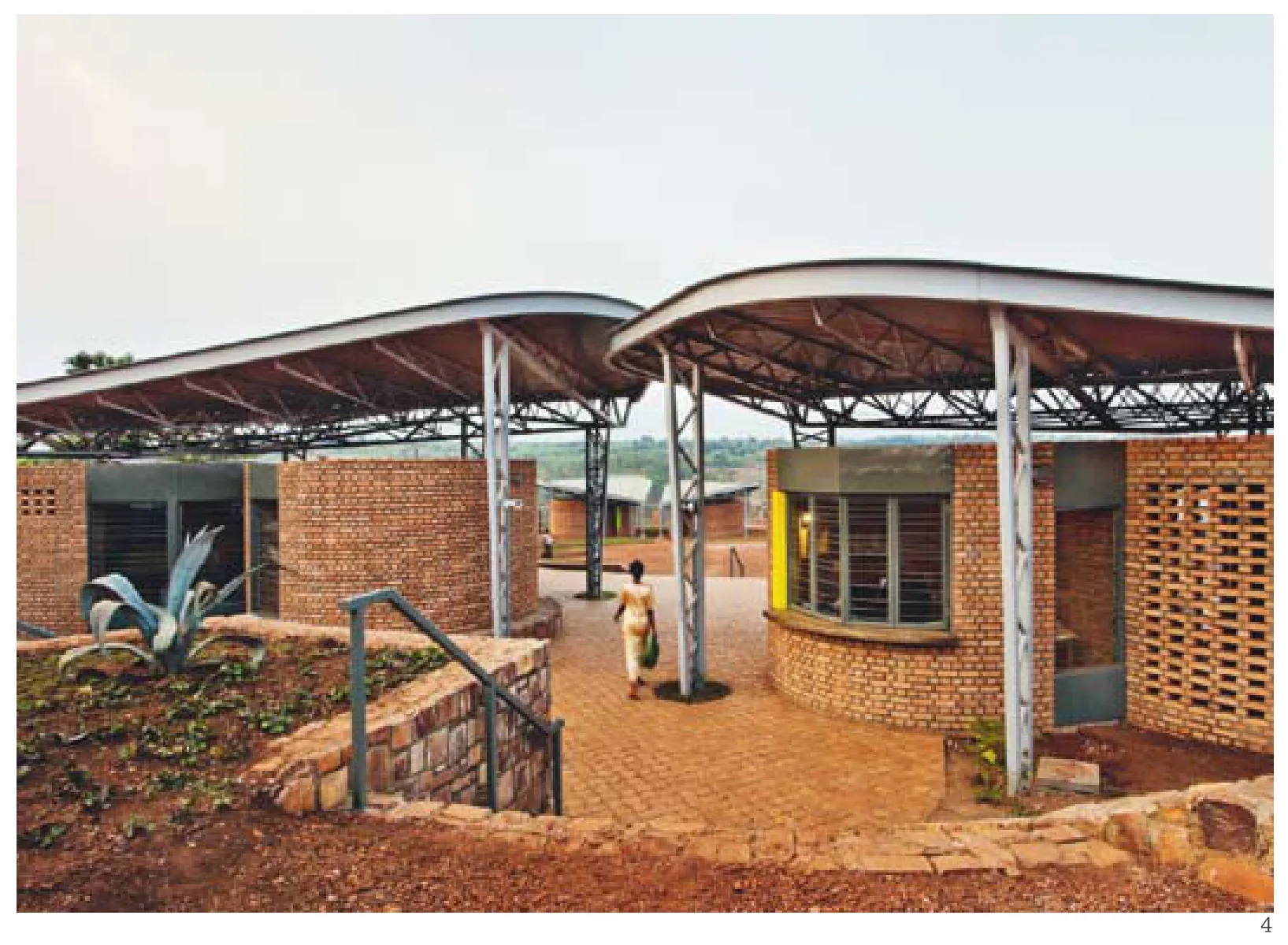
4 相对独立的屋顶结构/Free-standing roof construction
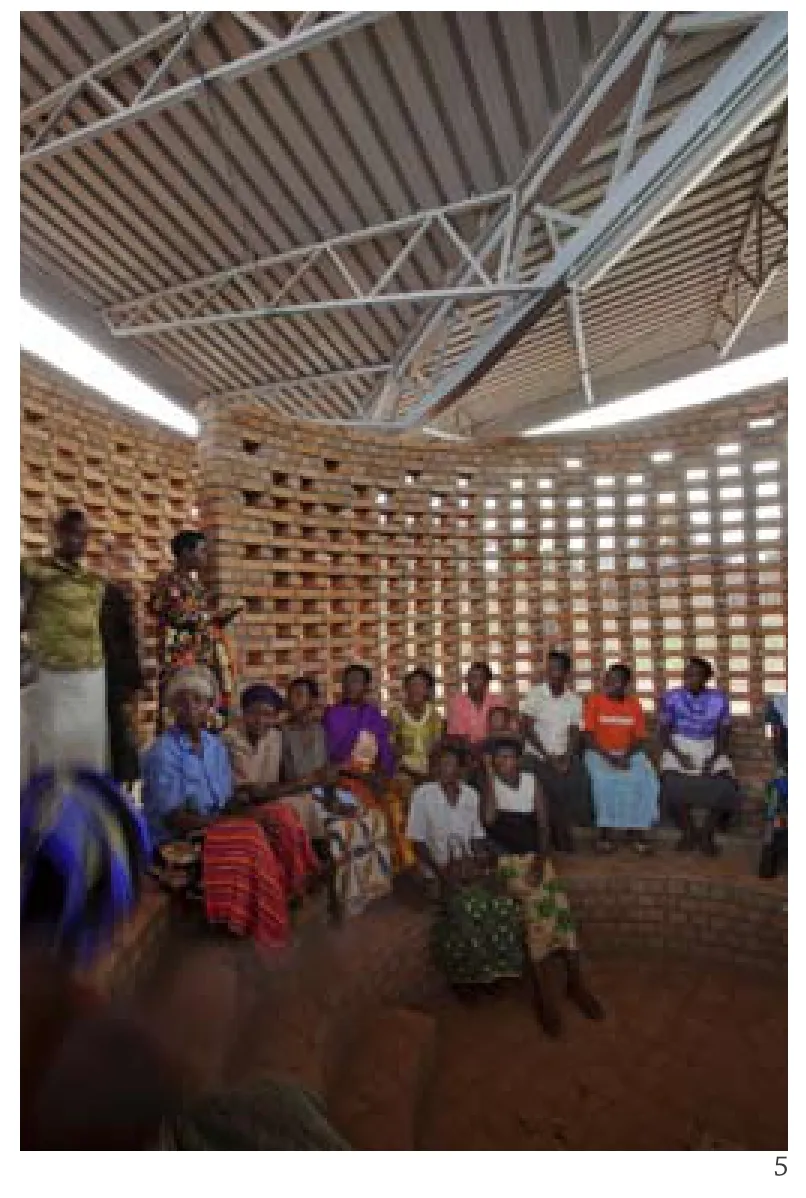
5 内景/Interior view
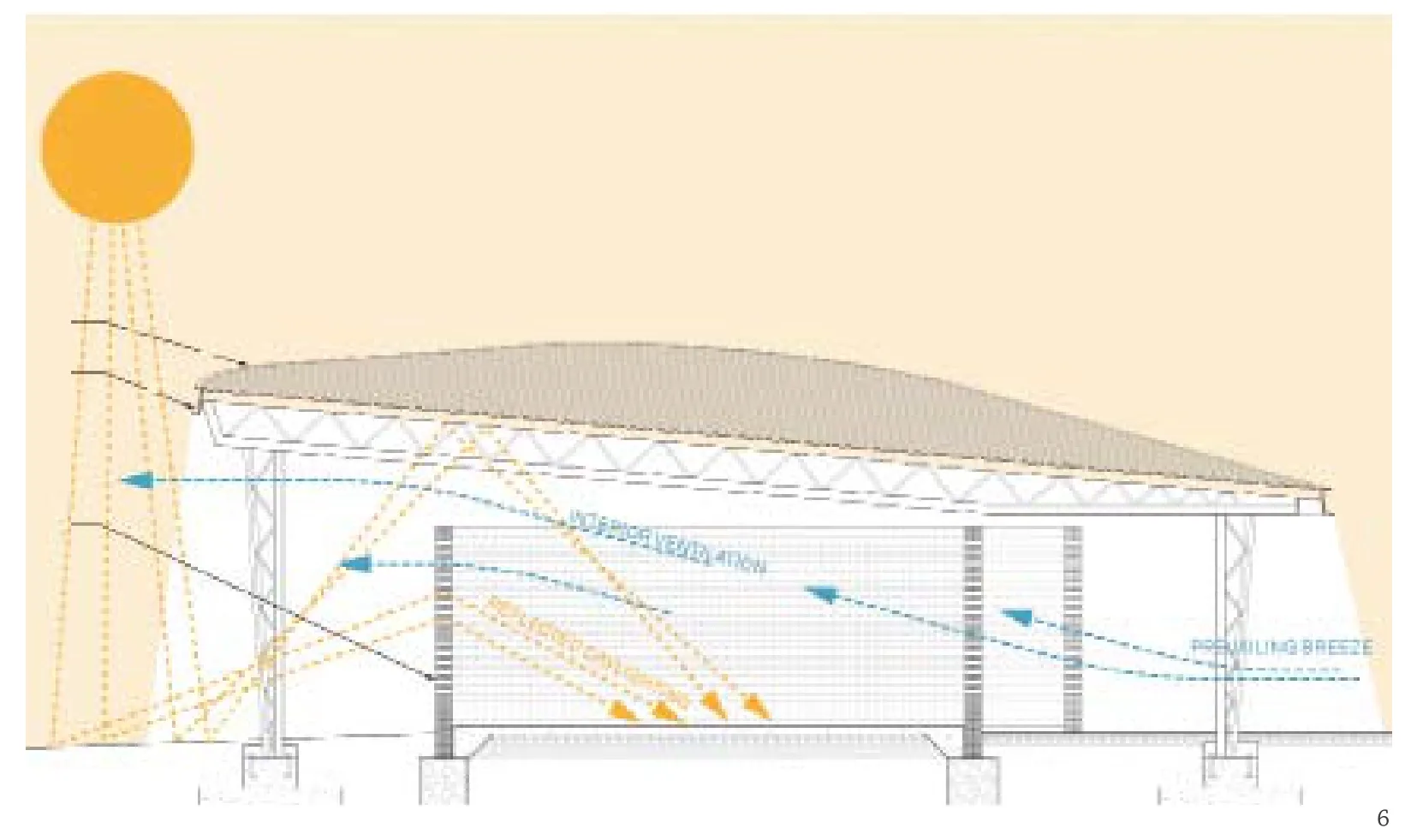
6 气候概念示意图/Schematic diagram of the climate concept showing cross-ventilation and lighting
评论
王丽方:项目主要的工作在妇女劳作、制砖技术、市场运营等方面。那无疑是具有价值的。砖建筑在这里基本是产品展销。当然也是项目的形象。
圆柱的形体选得聪明,正可以用到砖砌的优势。花格墙需要仔仔细细地砌,不能马虎。钢结构屋顶实现起来显然是最困难的,但也都成功了。这样的做法很接地气,却又显得超拔。当地人看,这是一群非常新颖不同凡响的建筑,广告效果不一般。学建筑的人看,这样土土的、接了地气的设计,显得聪明而且用心,很有别致的情趣。
砖,从早期文明传来的材料,如今在非洲的土地上,由非洲的妇女使用着,外来的建筑师综合了这一切,给当地塑造了一小片地域的标志。

8-10 手工砖的制作/Making of bricks
朵宁:妇女发展促进中心的平面,让人一下子想起列维·施特劳斯在《忧郁的热带》一书中所描绘的巴西土著部落的典型布局平面:中心是公共活动广场和祭祀空间,四周围绕着部落成员的土屋和其他功能空间。本项目的建设过程,也利用了当地妇女自制的砖块,并帮助她们发展出有竞争力的生产技能。在这种充分尊重本地传统和居民的设计前提下,脱离的钢结构屋架和螺旋形的砖砌花墙,用结构和构造语汇进一步呼应了社区结构,提高了设计的整体性和完成度。
Comments
WANG Lifang: The main task of the project lie in the expression of labor, brick-making technology and market operation by women, which are valuable. Brick building here is basically an exhibition of production,which is also the image of the project.
The selection of a cylinder shape is smart for it can display the advantage of masonry. The lattice wall needs careful brickwork instead of sloppy one. It is valuable to realize the most difficult part, the steelstructured house roof, which is down to earth and transcendent. In the eyes of local people, these are original and unique buildings with extraordinary effect of advertisement. According to people who study architecture, such rustic and reliable design shows ingenuity with unique taste.
Bricks, the material dating back to early civilizations, are now used by women in Africa. Foreign architects have taken the material into consideration and made it a landmark patch.
DUO Ning: The plan of the Center immediately reminds us of the typical layout of Brazilian indigenous tribes depicted in Tropical Depression by Levi Strauss.The center of it is the public square and religious space,surrounded by the earth houses of tribal members and other functional spaces. The construction of the project also used the bricks made by local women and helped them develop competitive skills for production. In the premise of fully respecting local tradition and residents, the isolated steel-structured roof truss and spiral-shaped brick lattice wall further echoed the organization of the community in terms of structure and construction vocabulary, and improved the entirety and completion of the design.
Women's Opportunity Center, Kayonza, Rwanda, 2013
Architects: Sharon Davis Design
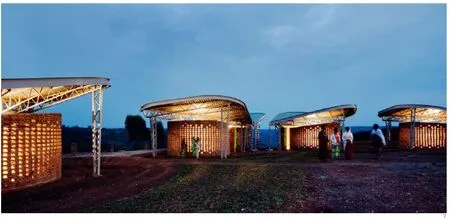
7 夜景/Night view
